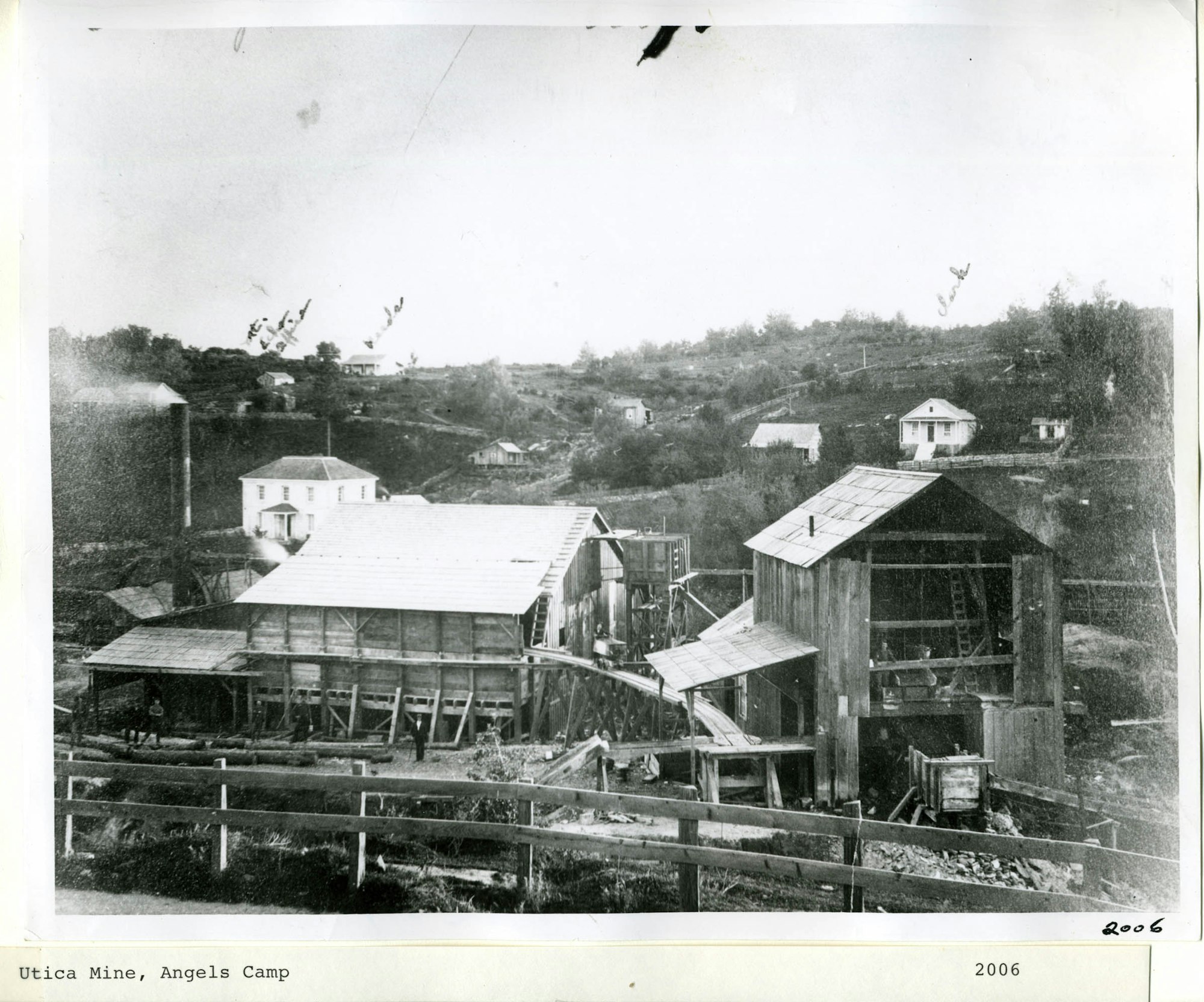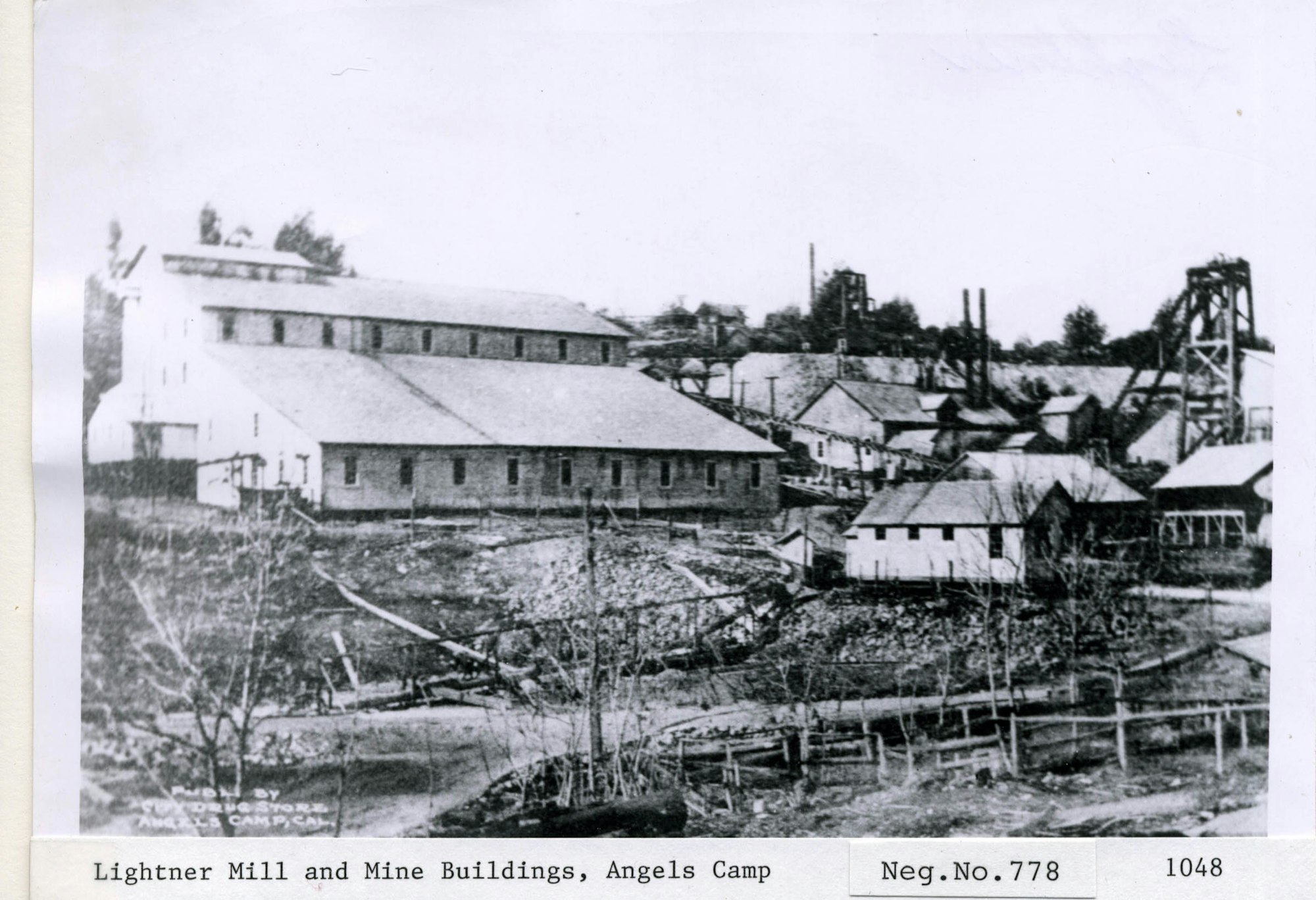Utica Park History
Utica Park is located on land that has been mined since the earliest days of the Gold Rush, first by placer mining and shortly thereafter by hard rock mining. Located on the Mother Lode Vein, the park was developed on the site of the famous Utica Quartz Mine, with the Lightner Quartz Claim to the north, Crystal Quartz Claim to the northwest, Jackson/Duffy to the west, Confidence to the southwest, and Stickles to the south. The mines boomed in the late 1880s through World War I, but closed forever during World War I.

The park has its beginnings in 1914, when the Angels Camp Women’s Improvement Club offered plans for a park, but World War I interrupted and it wasn’t until 1931 that the Utica Park idea was again revived. The site selected was the former location of the Utica Mining Company (UMC) mine and mill, from where the former mill had been removed in 1903 and relocated to the Stickles-Utica mine. By the end of World War I, there were no longer any mining or milling improvements on the site.

Although in 1928, a Boy Scout troupe, led by local teacher Ed Leonard, had planted a redwood tree donated by Calaveras Big Trees State Park, it wasn’t until January of 1931 that the park had its official beginnings. On January 22 of that year, a meeting was held at the Calaveras Hotel on Main Street for those interested in the development of a community park for Angels Camp. After discussion, it was decided by those present that it would be named “Utica Park,” as it was located on land owned by the UMC. Evidently the company had simply allowed the public to use the area as a community area.
A second meeting was held on January 29th of the newly formed Utica Park Development Association (UPDA) to select officers of the organization. Ed C. Leonard was elected president; Mrs. Millie Smith, vice-president; S.T. Johnson, secretary; Mrs. Sylvia Murray, treasurer; with A. May. Dr. G.P. Cooper, and A.C. Wilson, directors. W.H. Auten was named as a committee to survey the park, and H.R. Barden was to secure information on landscape gardening. Al Wilson, as superintendent of the UMC, pledged the wholehearted support of the company to the park movement. Membership of the association, under the direction of Charles Crespi, was open to all persons interested in park development. Their first decision was to plant the living Christmas Tree and erect a flagpole.
On the first Sunday in February a crew of volunteer workers gathered at Utica Park to level the land and fill up an old abandoned shaft. W.H. Auten had completed the maps of the park, and they were turned over to the art department at Bret Harte High School, where the pupils were sketching an art layout of the grounds; with plans and drawings presented to the Board to select a winner. In mid-February a flag pole with weather vane and two electric lights were donated by the UMC and erected at the park, and also donated a drinking fountain and donated water. The Boosters Club were asked to erect a 50 x 50 foot frog pond around the flag pole so that “the citizens of Angels may have an abundance of frogs handy when asked by tourists about the ‘Jumping Frog of Calaveras.’”
On March 16, it was noted that Utica Park was being beautified, with individuals and organizations at work on plots allotted to them. The Princess Parlor, NDGW, spent several days planting and beautifying their plot, and C.V. Goodloe had done “splendid work” on his upper corner plot. The site for a tennis court had been cleared and plans laid for its building. In March also, “the cabin of George Angels, founder of the town (sic)” was moved from its original location to the park, as was a summer house (round band pavilion), part of the old Hubler Brewery, donated by A.C. Mentz. People who donated shrubs and plants were asked to leave them in the “round house” for the gardener to plant.
Improvements in the park continued through April, with J.H. Shrum donating 100 lily bulbs; Mrs. Job Whiteside, 2 yew trees and 5 sequoias; Mrs. Lee Raggio, a tree; Cornelia Barden and Edward Stevenot, a wildflower bed; M.E. Patterson, lumber for the children’s playground; Mrs. Millie Smith, flag pole, L. Monte Verde, use of road equipment, Miss Agnes Snyder, tennis net; Angels Women’s Club and Mrs. C.H. McClory, benches; and H.R. Barden and Harry Hogarth, donations of labor. Many cash donations had also been sent to the finance committee.
In June, Mrs. Mary Dana donated a concrete bench, and Gus Swanson donated water lilies for the frog pond. It was in this month that the park entrance was erected. It consisted of two pillars made from old mine skips, with a track across the top supporting a mine car. Suspended from the car was an old ox yoke, and from that a bucket made from skins, used in pioneer days to carry water. The skips and cars were donated by the UMC, which also donated some of the mine floodlights which were stationed on each side of the frog pond. Mrs. H. Baumhogger and Mrs. Mollie McNutt planted petunias and French marigolds. Unfortunately, the frog pond was not a success, as seeping water leaked into the openings to the mine and frogs and water disappeared.
This was presumably the end of major work on the park for many years, as there were no more accounts in the Calaveras Californian until 1944, when Warner Bros. donated the Mark Twain Statue. Articles that May described three major activities to highlight the two-day Frog Jubilee: the special Angels Camp showing Saturday night of Warner Bros. The Adventures of Mark Twain, starring Frederic March and Alexis Smith, and featuring an appearance of several stars from the cast; the unveiling at 11 o’clock Sunday morning of a life-sized statue of Mark Twain; and, of course, the internationally famous jumping frog contest itself. The event included selections by the Miners’ Band and talks by an impressive array of distinguished celebrities from the literary, educational, and entertainment worlds.
At the Sunday Jubilee on May 25, the world’s frog jump record was set by ‘Maggie,’ a Stockton frog, after the Mark Twain Stature dedication that morning. The monument was constructed by P.C. Manuelli, a famous Italian sculptor, and depicted Mark Twain surrounded by frogs jumping from bullrushes. Talks were given by Dr. Aurelia Reinhardt, president of Mills College; Jesse L. Laskey, producer of the film, Adventures of Mark Twain, and Raymond Williamson, grand president of the NSGW. C.T. Mills gave a brief history of the Utica Mines and the land now occupied by the park. Unfortunately, the Mark Twain monument was damaged in June 1957, when members of the Hells Angels Motorcycle Club took over Angels Camp and hacksawed the frogs off its base.
On January 24, 1954, the Park Association asked the City to finance the park, and a volunteer program was developed. The ground was again leveled and the old north Utica shaft filled above the 60-foot level. Volunteer organizations took on the work of planting the area. Over the years a children’s playground and other features were added to make the park a popular meeting place for the City and tourists.
It is unknown what happened to the original features in the park (summer house, Angels’ cabin, concrete bench, flag pole, etc.), but more recent installations include a 1961 memorial to three Bret Harte High School boys who were killed in the Vietnam conflict: Gene Bettger, Clenn Whittle, Jr., and Anthony Albasio; and a water fountain donated by the Soroptimist Club in the name of Isabelle Gualdoni.
Other Features in the Park
Residential Parcels, Lots 5, 6, and 7, Block 8 of Angels Camp Townsite. In addition to the original Utica Quartz Mine Claim, three residential parcels of land were located in the northeast corner of the present park and were later acquired by the UMC. When the Angels Camp Townsite was platted in 1871, the name Mineer was depicted on Lot 7; this may have been Norham Minear, a miner who resided in Angels Camp in 1860, but additional research is required to determine the exact person.
Lot 5, however, belonged to Giovanni (John) Baptiste Vicini, born in the city of Genoa, Italy, in 1834. He registered to vote in 1867 in Angels Camp, presumably residing in the same location. A boot and shoemaker by trade, in 1870 he was listed as age 34, with Italian wife Catarina, aged 23, with nine miners boarding with them. He was assessed for leather, thread, pegs, and nails, as well as a house and fence. By 1876, the family had moved to Sutter Creek, where they raised a family, John plied his trade, became a farmer, a capitalist, and eventually resided with his son Stephen, a hotel proprietor on Main Street. He died in Sutter Creek in 1925.
Vicini’s Angels Camp property was sold to Alvinza Hayward of San Mateo and Charles Lane (Utica Mining Company) in August of 1894 for $250. By 1918, the UMC was assessed for the “Cross Warehouse” on the property, presumably a warehouse for the Cross Shaft, located at the top of Rasberry Lane.
It appears likely that the large old pear tree located in front of the refreshment building was located on the Vicini property, as may have been other fruit trees in the park.
Stone Foundation. Located just north of the Restroom facility, this was the foundation for the hoist for the Utica Mine, probably built in the late 1880s.
Stairway. A concrete and stone stairway of 6+ steps is located on the hillside leading to Main Street. Its use is unknown, as it only accesses a concrete pad, and doesn’t continue on to the street.
Concrete Post. A concrete post, located on the southwest side of Main Street above the park, appears to mark the boundary between the Altaville and Angels Camp Townsites.
By Judith Marvin, July 2019; Prepared for Amy Augustine, City of Angels Camp
REFERENCES
Ancestry.com
Beauvais, A.B.
1871 Plat of Angels Camp, Calaveras County. Surveyed and Drawn by A.B. Beauvais, County Surveyor of Tuolumne County, Cal.
var. Calaveras Californian, Angels Camp, Californian. Researched from 1928-1944. On file, Calaveras County Archives, San Andreas.
Calaveras, County of
var. Deed Books
Assessment Rolls
Leonard, Edward C.
1971 “The Mills of Angels.” Las Calaveras, Quarterly Bulletin of the Calaveras County Historical Society, Volume XIX, Number 2, January 1971, San Andreas.
1973 “A Brief History of Angels Camp, Home of the Jumping Frog.” Old Timer’s Museum, Museum, Murphys, California.
Marvin, Judith
2011 Principal Investigator. Historic Resources Inventory and Evaluations, Historic Commercial Center, with Scope of Work and Justification, Façade Improvement Program, Angels Camp, Calaveras County, California. Prepared under Community Development Block Grant #08-EDEF-5782. Prepared for David Hanham, Planning Director, City of Angels, Angels Camp, California. Included monitoring of work.
